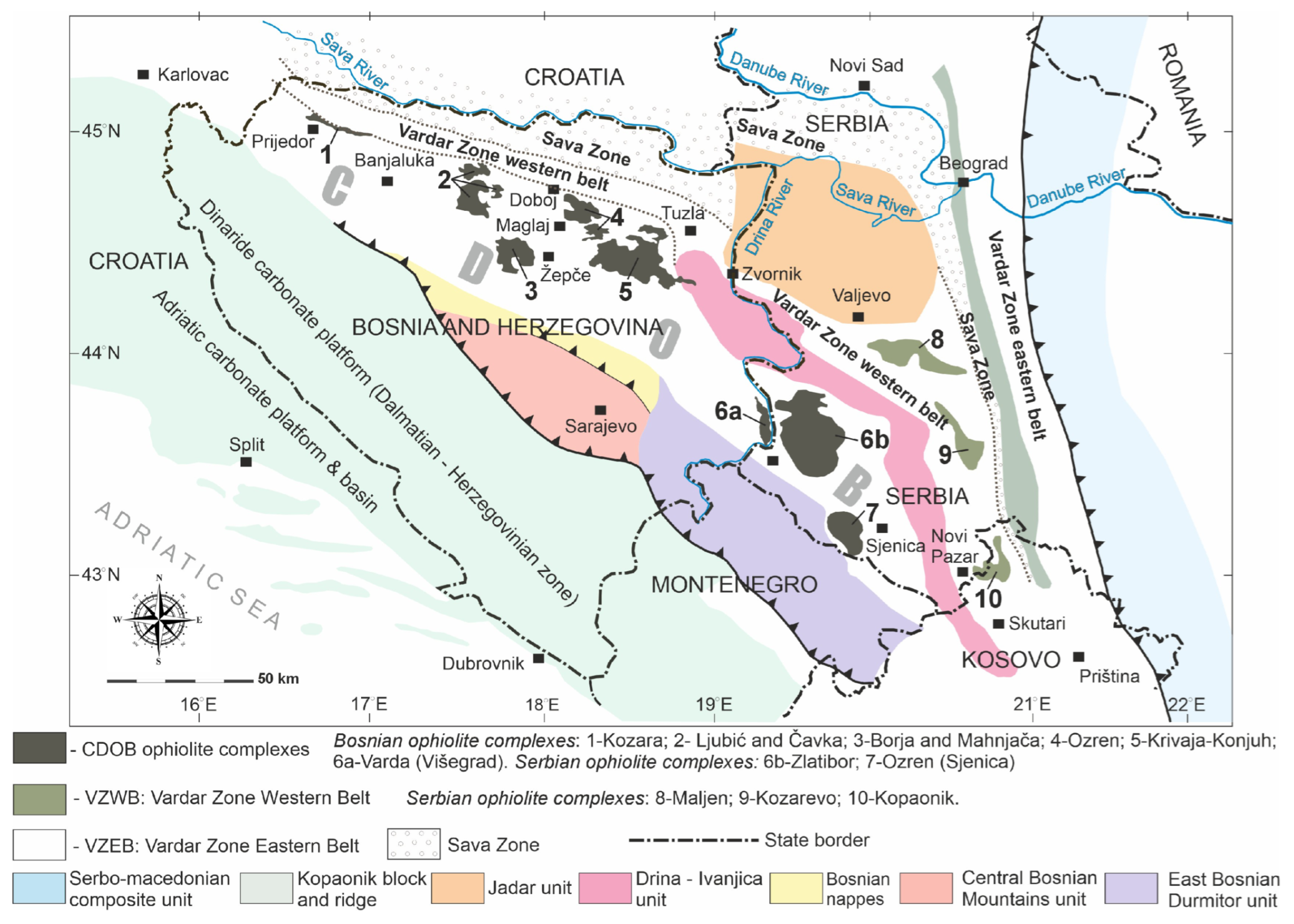Amphibole Group Minerals in the Ozren Massif Ophiolites of Bosnia and Herzegovina as Petrogenetic Indicators
Abstract
1. Introduction
2. Geological Setting
3. Materials and Methods
Methodical Approach for the Calculation of Amphiboles
- All amphiboles are calculated with [28] Excel Spreadsheet;
- Calculations are based on 15 cations following one of 2 procedures: (1) Si to Ca&Li = 15 apfu for Ca amphiboles (Mhbl, Prg, and Hst) and (2) Si to Na = 15 apfu for Gru, Krs, and Wnc;
- Fe3+ was calculated based on charge balance;
- OH was calculated based on assumption 2 (OH, F, and Cl);
- Mineral formula assigned based on 24 anions.
4. Results
4.1. Petrographic Description of Samples
4.2. Chemical Composition of Amphiboles
4.3. Results of Micro-Raman Spectroscopy
4.4. Amphibole Geothermobarometry Results
4.4.1. Magmatic Amphiboles
4.4.2. Amphiboles from Ultramafic Rocks and Alteration Zones
4.4.3. Metamorphic Amphiboles
5. Discussion
5.1. Mineral Composition of Amphibole Generations and Petrogenetic Significance
5.2. Relationship of Chemical Composition and Micro-Raman Spectroscopy Data
5.3. Amphibole Geothermobarometry Estimates
6. Conclusions
- The complex geological setting of the Ozren ophiolite complex is also confirmed by the compositionally diverse amphiboles. Here, we determined members of the monoclinic magnesium–iron–manganese amphiboles (Gru), calcium amphiboles (Mhbl, Prg, Hst, Sdg to Ti-Sdg, and Tr), sodium–calcium amphiboles (Fe-Wnc to Fwnc Ktp to Fktp), and oxo amphiboles (Krs and Fkrs).
- The chemical composition of the studied amphiboles provided a very good correlation with the analyzed Raman spectra.
- Electron probe micro-analysis (EPMA), micro-Raman study, and Amp geothermobarometry constrained the genetically different Amp groups and types (Table 3) in the investigated oceanic crust and mantle rocks:
- 4.
- ‘Dry’ percolating melts are most likely generated in an extensional subridge setting, while ‘hydrated’ Amp-bearing rocks may have been influenced by arc-type magmas and fluids, implying a change from the mid-ocean ridge (MOR) to a supra-subduction zone (SSZ) setting of the Ozren ophiolite complex.
Supplementary Materials
Author Contributions
Funding
Data Availability Statement
Acknowledgments
Conflicts of Interest
References
- Welch, D.M. Amphiboles. In Encyclopedia of Geology, 2nd ed.; Elias, S., Alderton, D., Eds.; Academic Press: Cambridge, MA, USA, 2020; pp. 297–300. ISBN 978-0081029084. [Google Scholar]
- Dilek, Y.; Furnes, H. Ophiolite genesis and global tectonics: Geochemical and tectonic fingerprinting of ancient oceanic lithosphere. Geol. Soc. Am. Bull. 2011, 123, 387–411. [Google Scholar] [CrossRef]
- Basch, V.; Rampone, E.; Crispini, L.; Ferrando, C.; Ildefonse, B.; Godard, M. Multi-stage Reactive Formation of Troctolites in Slow-spreading Oceanic Lithosphere (Erro–Tobbio, Italy): A Combined Field and Petrochemical Study. J. Petrol. 2019, 60, 873–906. [Google Scholar] [CrossRef]
- Itano, K.; Morishita, T.; Nishio, I.; Guotana, J.M.; Ogusu, Y.; Ishizuka, O.; Tamura, A. Petrogenesis of amphibole-rich ultramafic rocks in the Hida metamorphic complex, Japan: Its role in arc crust differentiation. Lithos 2021, 404, 106440. [Google Scholar] [CrossRef]
- Alonso-Perez, R.; Müntener, O.; Ulmer, P. Igneous garnet and amphibole fractionation in the roots of island arcs: Experimental constraints on andesitic liquids. Contrib. Mineral. Petrol. 2009, 157, 541–558. [Google Scholar] [CrossRef]
- Ishimaru, S.; Arai, S.; Tamura, A.; Takeuchi, M.; Kiji, M. Subarc magmatic and hydration processes inferred from a hornblende peridotite xenolith in spessartite from Kyoto, Japan. J. Mineral. Petrol. Sci. 2009, 104, 97–104. [Google Scholar] [CrossRef]
- Tiepolo, M.; Langone, A.; Morishita, T.; Yuhara, M. On the Recycling of Amphibole-rich Ultramafic Intrusive Rocks in the Arc Crust: Evidence from Shikanoshima Island (Kyushu, Japan). J. Petrol. 2012, 53, 1255–1285. [Google Scholar] [CrossRef]
- Putiš, M.; Nemec, O.; Ustalić, S.; Babajić, E.; Ružička, P.; Koller, F.; Kurylo, S.; Katanić, P. Mineralogical-Petrographical Record of Melt-Rock Interaction and P–T estimates from the Ozren Massif Ophiolites (Bosnia and Herzegovina). Minerals 2022, 12, 1108. [Google Scholar] [CrossRef]
- Colombo, F.; Rius, J.; Molins, E.; Biglia, H.; Galliski, M.Á.; Márquez-Zavalía, M.F.; Baldo, E.G.A.; Kriscautzky, A. Ferro-ferri-katophorite, a new clinoamphibole from the silicocarbonatite dykes in Sierra de Maz, La Rioja, Argentina. Mineral. Mag. 2023, 87, 324–330. [Google Scholar] [CrossRef]
- Schmid, S.M.; Bernoulli, D.; Fügenshuh, B.; Matenco, L.; Schefer, S.; Schuster, R.; Tischler, M.; Ustaszewski, K. The Alpine–Carparthian–Dinaric orogenic system: Compilation and evolution of tectonic units. Swiss J. Geosci. 2008, 101, 139–183. [Google Scholar] [CrossRef]
- Robertson, A.; Karamata, S.; Šarić, K. Overview of ophiolites and related units in the late Palaeozoic–early Cenozoic magmatic and tectonic development of Tethys in the northern part of the Balkan region. Lithos 2009, 108, 1–36. [Google Scholar] [CrossRef]
- Trubelja, F.; Pamić, J. Petrologic study of mountain Ozren in the north of Bosnia. Acta Geol. 1965, IV, 265–314. [Google Scholar]
- Lugović, B.; Altherr, R.; Raczek, I.; Hoffmann, A.; Majer, V. Geochemistry of peridotites and mafic igneous rocks from the Central Dinaric ophiolite belt, Yugoslavia. Contrib. Mineral. Petrol. 1991, 106, 201–216. [Google Scholar] [CrossRef]
- Pamić, J.; Tomljenović, B.; Balen, D. Geodynamic and petrogenetic evolution of Alpine ophiolites from the central and NW Dinarides: An overview. Lithos 2002, 65, 113–142. [Google Scholar] [CrossRef]
- Karamata, S. The geological development of the Balkan Peninsula related to the approach, collision and compression of Gondwanan and Eurasian units. Geol. Soc. Lond. Spec. Publ. 2006, 260, 155–178. [Google Scholar] [CrossRef]
- Bazylev, B.A.; Popević, A.; Karamata, S.; Kononkova, N.N.; Simakin, S.G.; Olujić, J.; Vujnović, L.; Memović, E. Mantle peridotites from the Dinaridic ophiolite belt and the Vardar zone western belt, Central Balkan. Lithos 2009, 108, 37–71. [Google Scholar] [CrossRef]
- Ustaszewski, K.; Kounov, A.; Schmid, S.M.; Schaltegger, U.; Krenn, E.; Frank, W.; Fügenschuh, B. Evolution of the Adria-Europe plate boundary in the northern Dinarides: From continent-continent collision to back-arc extension. Tectonics 2010, 29, TC6017. [Google Scholar] [CrossRef]
- Morishita, T.; Dilek, Y.; Shallo, M.; Tamura, A.; Arai, S. Insight into the uppermost mantle section of a maturing arc: The eastern Mirdita ophiolite, Albania. Lithos 2011, 124, 215–226. [Google Scholar] [CrossRef]
- Faul, U.H.; Garapić, G.; Lugović, B. Subcontinental rift initiation and ocean-continent transitional setting of the Dinarides and Vardar zone: Evidence from the Krivaja–Konjuh Massif, Bosnia and Herzegovina. Lithos 2014, 202, 283–299. [Google Scholar] [CrossRef]
- Šegvić, B.; Slovenec, D.; Schuster, R.; Babajić, E.; Badurina, L.; Lugović, B. Sm-Nd geochronology and petrologic investigation of a sub-ophiolite metamorphic sole from the Dinarides (Krivaja-Konjuh Ophiolite Complex, Bosnia and Herzegovina). Geol. Croat. 2020, 73, 119–130. [Google Scholar] [CrossRef]
- Balen, D.; Massonne, H.J. Two contrasting P-T paths for metamorphic sole amphibolites of the Dinaride Ophiolite Zone (Krivaja-Konjuh ultramafic massif, Central Bosnia and Herzegovina) and their geodynamic implications. Lithos 2021, 394, 106184. [Google Scholar] [CrossRef]
- Ustalić, S.; Putiš, M.; Nemec, O.; Ružička, P.; Babajić, E.; Katanić, P. Petrography of ultrabasic and basic rocks from the Ozren ophiolite complex in Bosnia and Herzegovina. In Proceedings of the 15th Emile Argand Conference on Alpine Geological Studies: Abstract Book and Fieldtrip Guide, Ljubljana, Slovenia, 12–14 September 2022; Volume 66. [Google Scholar] [CrossRef]
- Ustalić, S.; Putiš, M.; Babajić, E.; Nemec, O.; Ružička, P. Lithological cross-section and mineralogical-petrographical characterization of the Ozren and Borja-Mahnjača ophiolite complexes in Bosnia and Herzegovina. In Proceedings of the Scientific Conference of the Slovak Geological Society, Newsletter of the SGS Mente et Malleo 2/2022, Abstracts, Bratislava, Slovakia, 13 January 2023; pp. 47–48. [Google Scholar]
- Soták, J.; Ustalić, S.; Putiš, M.; Babajić, E.; Ružička, P. New radiolarian data from the Ozren ophiolite complex in Bosnia and Herzegovina. In Proceedings of the III Congress of Geologists of Bosnia and Herzegovina with International Participation, Neum, Bosnia and Herzegovina, 21–23 September 2023; pp. 38–41. [Google Scholar]
- Ustalić, S.; Soták, J.; Putiš, M.; Babajić, E.; Ružička, P. Comparative study of radiolarians from the Ozren and Borja-Mahnjača Dinaridic ophiolitic massifs in Bosnia and Herzegovina. Sci. Conf. Slovak Geol. Soc. Newsl. SGS Mente Et Malleo 2023, 2023, 29. [Google Scholar]
- Sunarić-Pamić, O.; Pamić, J.; Kapelar, I.; Olujić, J.; Zec, F. The Basic Geological Map of the Former SFR Yugoslavia 1:100 000, Geological Sheet Zavidovići. Repub. Geol. Surv. Geol. Surv. Sarajevo Bosnia Herzeg. 1971. [Google Scholar]
- Laušević, M.; Jovanović, Č. The Basic Geological Map of the Former SFR Yugoslavia 1:100,000, Geological Sheet Doboj. Repub. Geol. Surv. Geoinženjering Inst. Sarajevo Sarajevo Bosnia Herzeg. 1982. [Google Scholar]
- Locock, A.J. An Excel spreadsheet to classify chemical analyses of amphiboles following the IMA 2012 recommendations. Comput. Geosci. 2014, 62, 1–11. [Google Scholar] [CrossRef]
- Leake, B.E. Nomenclature of amphiboles. Mineral. Mag. 1978, 42, 533–563. [Google Scholar] [CrossRef]
- Hawthorne, F.; Oberti, R.; Harlow, G.; Maresch, W.; Martin, R.F.; Schumacher, J.; Welch, M. IMA report: Nomenclature of the amphibole supergroup. Am. Mineral. 2012, 97, 2031–2048. [Google Scholar] [CrossRef]
- Oberti, R.; Boiocchi, M.; Hawthorne, F.; Cámara, F.; Ciriotti, M.; Berge, S. Ti-rich fluoro-richterite from Kariasen (Norway): The oxo-component and the use of Ti4+ as a proxy. Can. Mineral. 2015, 53, 285–294. [Google Scholar] [CrossRef]
- Ridolfi, F. Amp-TB2: An Updated Model for Calcic Amphibole Thermobarometry. Minerals 2021, 11, 324. [Google Scholar] [CrossRef]
- Ernst, W.G.; Liu, J. Experimental phase-equilibrium study of Al- and Ti-contents of calcic amphibole in MORB; a semiquantitative thermobarometer. Am. Mineral. 1998, 83, 952–969. [Google Scholar] [CrossRef]
- Warr, L.N. IMA–CNMNC approved mineral symbols. Mineral. Mag. 2021, 85, 291–320. [Google Scholar] [CrossRef]
- Bonadiman, C.; Nazzareni, S.; Coltorti, M.; Comodi, P.; Giuli, G.; Faccini, B. Crystal chemistry of amphiboles: Implications for oxygen fugacity and water activity in lithospheric mantle beneath Victoria land, Antarctica. Contrib. Mineral. Petrol. 2014, 167, 984. [Google Scholar] [CrossRef]
- Bach, W.; Klein, F. The petrology of seafloor rodingites: Insights from geochemical reaction path modeling. Lithos 2009, 112, 103–117. [Google Scholar] [CrossRef]
- Bucher, K.; Grapes, R. Petrogenesis of Metamorphic Rocks; Springer: Berlin/Heidelberg, Germany, 2011; pp. 1–428. [Google Scholar] [CrossRef]
- Saveliev, D.E.; Puchkov, V.N.; Sergeev, S.N.; Musabirov, I.I. Deformation-induced decomposition of enstatite in mantle peridotite and its role in partial melting and chromite ore formation. Dokl. Earth Sci. 2017, 476, 1058–1061. [Google Scholar] [CrossRef]
- Putiš, M.; Li, X.-H.; Yang, Y.-H.; Li, Q.-L.; Nemec, O.; Ling, X.-X.; Koller, F.; Balen, D. Permian pyroxenite dikes in harzburgite with signatures of the mantle, subduction channel and accretionary wedge evolution (Austroalpine Unit, Eastern Alps). Lithos 2018, 314, 165–186. [Google Scholar] [CrossRef]
- Maffione, M.; van Hinsbergen, D.J.J. Reconstructing Plate Boundaries in the Jurassic Neo-Tethys from the East and West Vardar Ophiolites (Greece and Serbia). Tectonics 2018, 37, 858–887. [Google Scholar] [CrossRef]
- Apopei, A.I.; Buzgar, N. The Raman study of Amphiboles. Anal. Şt. Univ. Al. I. Cuza Iaşi–Geologie. Tomul LVI 2010, 1, 57–83. [Google Scholar]
- Andò, S.; Garzanti, E. Raman spectroscopy in heavy-mineral studies. Geol. Soc. Lond. Spec. Publ. 2013, 386, 395–412. [Google Scholar] [CrossRef]
- Waeselmann, N.; Schlüter, J.; Malcherek, T.; Della Ventura, G.; Oberti, R.; Mihailova, B. Nondestructive determination of the amphibole crystal-chemical formulae by Raman spectroscopy: One step closer. J. Raman Spectrosc. 2019, 51, 1530–1548. [Google Scholar] [CrossRef]
- Lafuente, B.; Downs, R.T.; Yang, H.; Stone, N. The power of databases: The RRUFF project. In Highlights in Mineralogical Crystallography; Armbruster, T., Danisi, R., Eds.; Walter de Gruyter GmbH: Berlin, Germany, 2016; pp. 1–29. [Google Scholar] [CrossRef]
- Susta, U.; Della Ventura, G.; Hawthorne, F.C.; Abdu, Y.A.; Day, M.C.; Mihailova, B.; Oberti, R. The crystal-chemistry of riebeckite, ideally Na2Fe2+3Fe3+2Si8O22(OH)2: A multitechnique study. Mineral. Mag. 2018, 82, 837–852. [Google Scholar] [CrossRef]
- Apopei, A.I.; Buzgar, N.; Buzatu, A. Raman and infrared spectroscopy of kaersutite and certain common amphiboles. Analele Stiintifice ale Universitatii Al. I. Cuza din Iasi. Seria Geologie. 2011, 57, 35–58. [Google Scholar]
- Wang, X.; Hou, T.; Wang, M.; Zhang, C.; Zhang, Z.; Pan, R.; Marxer, F.; Zhang, H. A new clinopyroxene thermobarometer for mafic to intermediate magmatic systems. Eur. J. Mineral. 2021, 33, 621–637. [Google Scholar] [CrossRef]
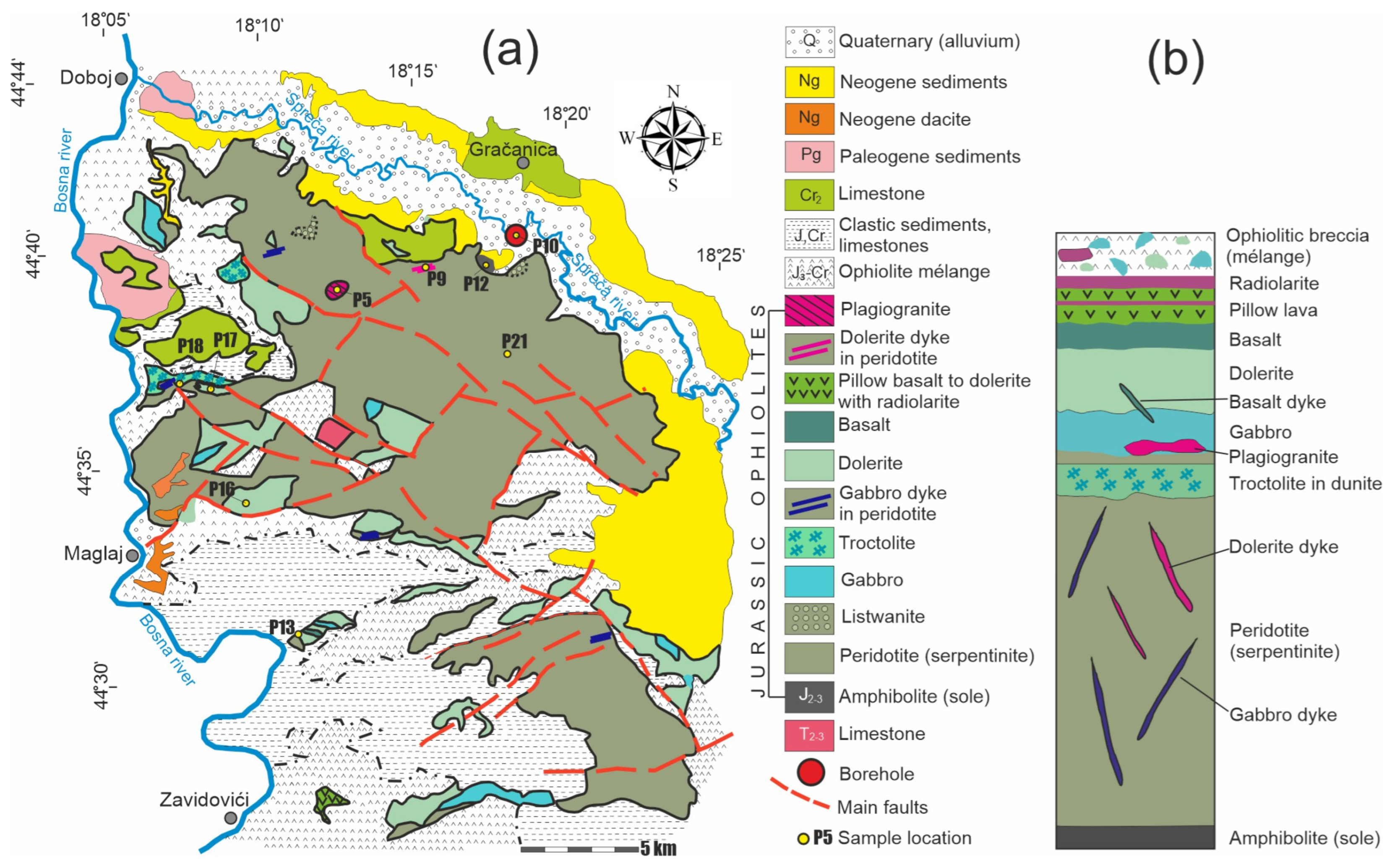
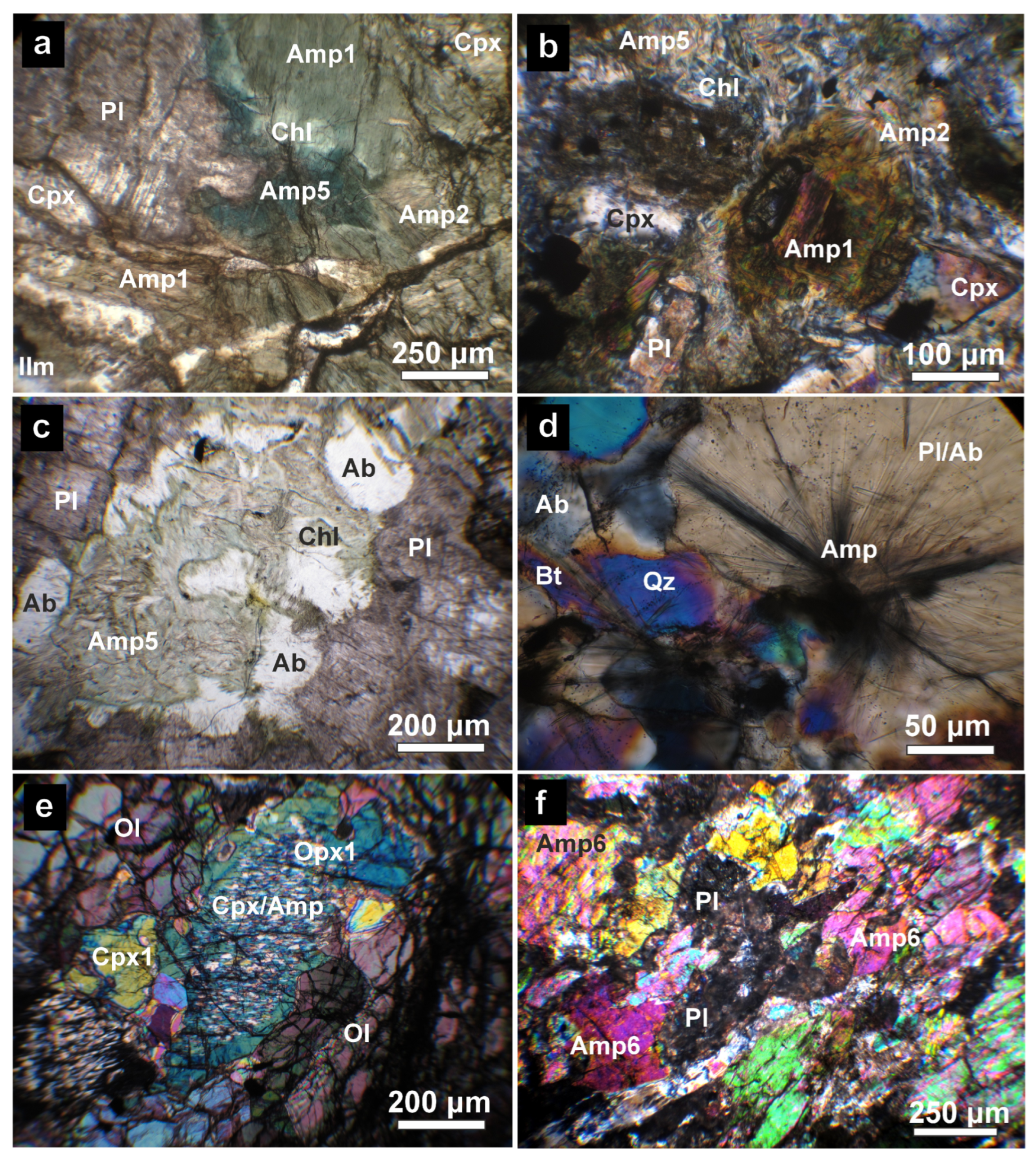
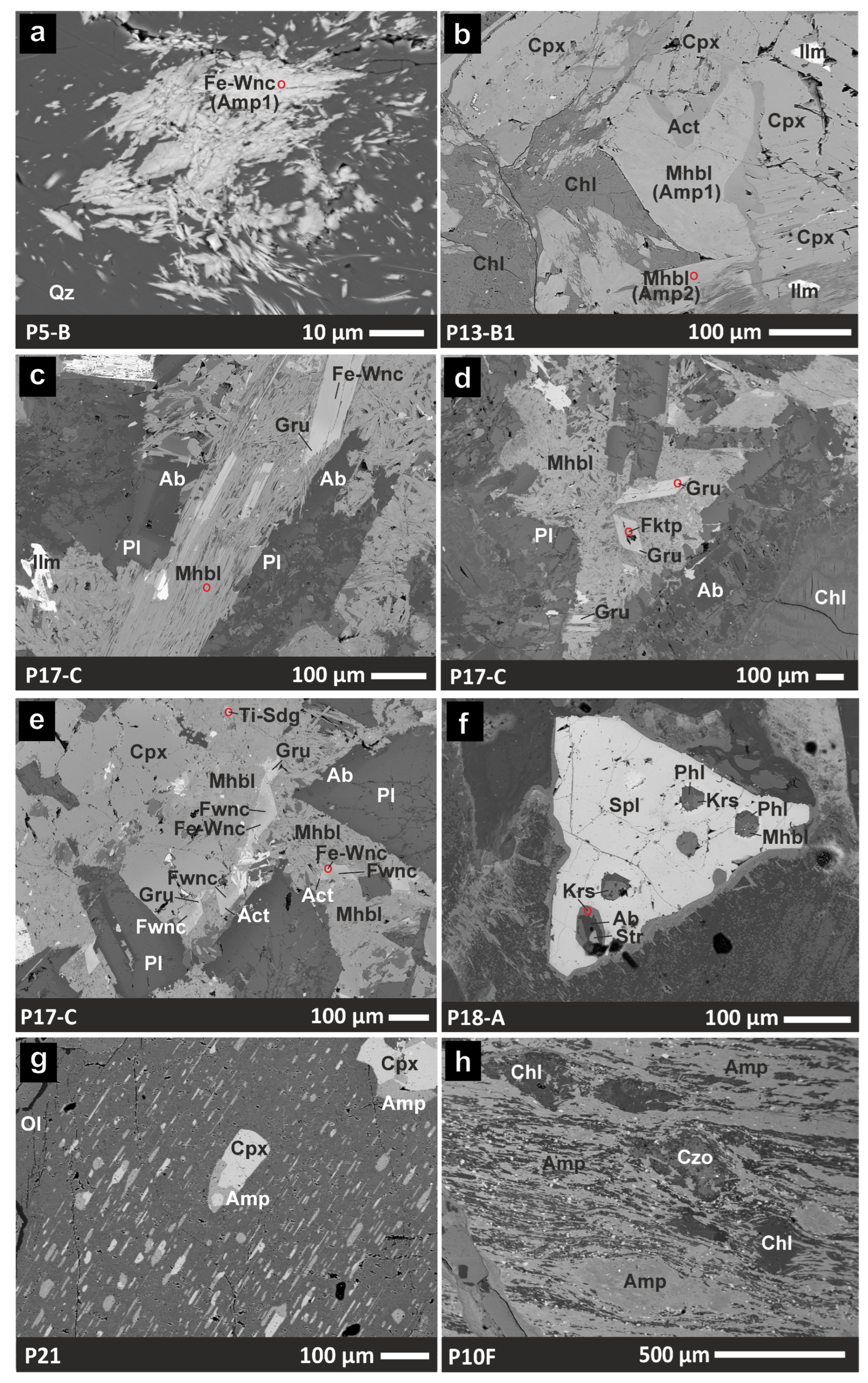
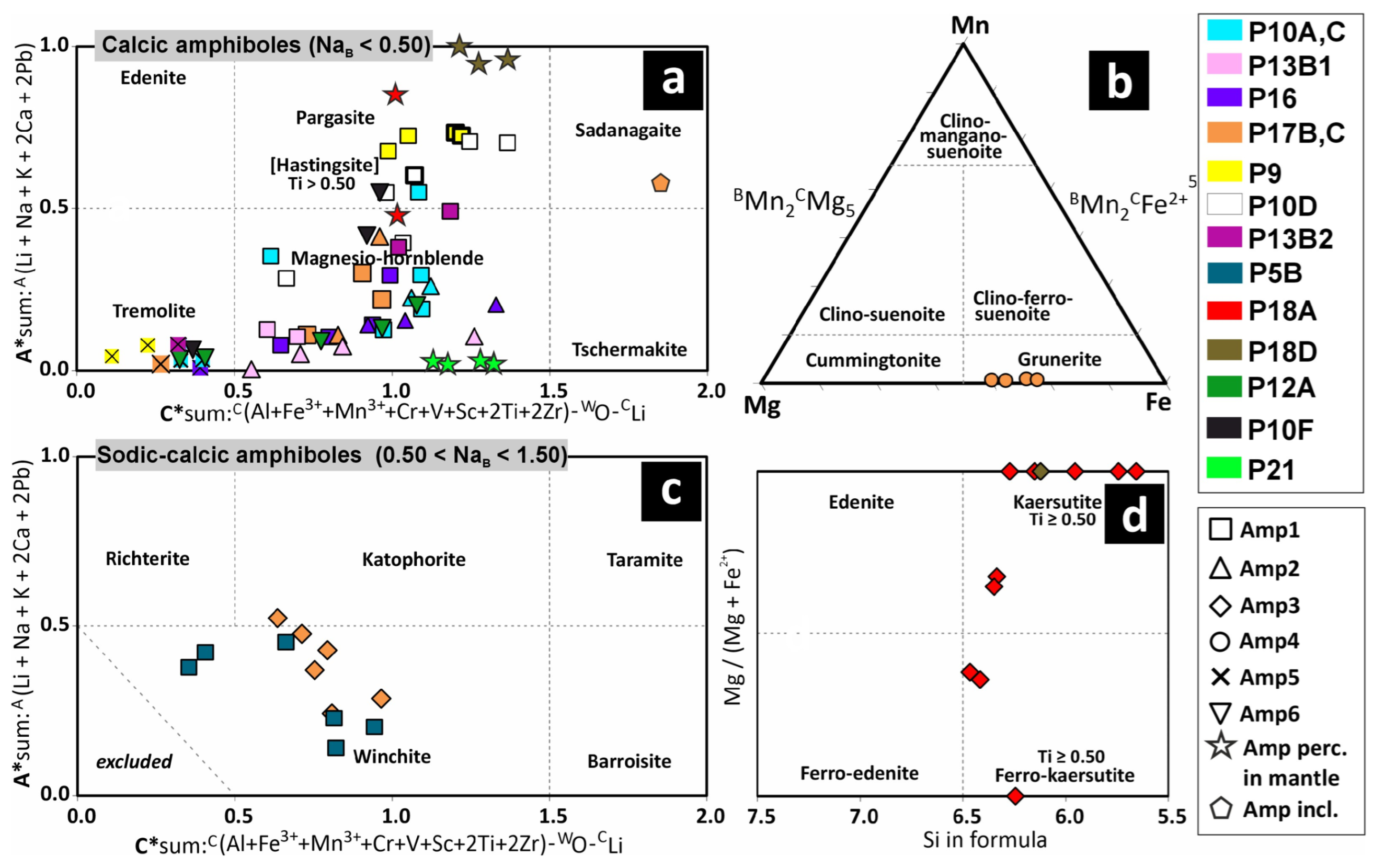
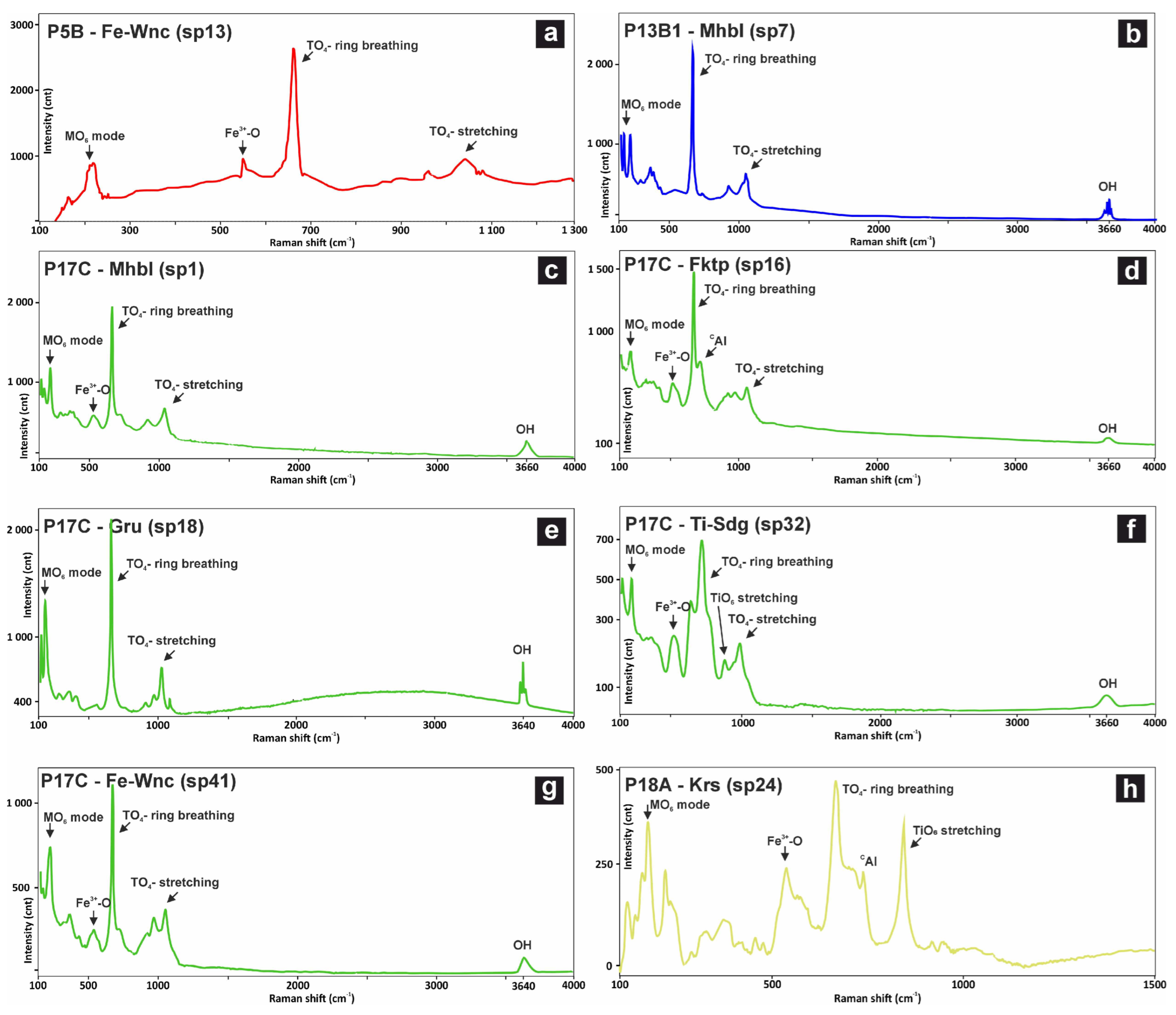
| Samples | GPS Coordinates |
|---|---|
| P5B Plagiogranite | N 44°39′1.80″, E 18°12′25.32″ |
| P9 Dolerite | N 44°39′43.82″, E 18°15′7.98″ |
| P10A Gabbro | N 44°40′36.61″, E 18°17′40.59″ |
| P10C Gabbro | N 44°40′36.61″, E 18°17′40.59″ |
| P10D Basalt | N 44°40′36.61″, E 18°17′40.59″ |
| P10F Amphibolite | N 44°40′36.61″, E 18°17′40.59″ |
| P12A Amphibolite | N 44°39′44.33″, E 18°17′25.70″ |
| P13B1 Gabbro | N 44°30′40.86″, E 18°11′29.58″ |
| P13B2 Leucogabbro | N 44°30′40.86″, E 18°11′29.58″ |
| P16 Dolerite | N 44°34′15.72″, E 18°9′18.84″ |
| P17B, C Dolerite | N 44°37′8.26″, E 18°8′11.46″ |
| P18A Troctolite | N 44°36′52.06″, E 18°7′4.42″ |
| P18D Dunite | N 44°36′52.06″, E 18°7′4.42″ |
| P21 Harzburgite | N 44°37′42.00″, E 18°13′58.86″ |
| Oxide (wt.%). | SiO2 | TiO2 | Al2O3 | Cr2O3 | FeO | MgO | CaO | Na2O |
|---|---|---|---|---|---|---|---|---|
| Harzburgite—P21 | ||||||||
| Amp-P21 (following Cpx exsol. lamellae in Opx) | 48.08–48.86 | 0.24–0.34 | 10.90–11.84 | 1.19–2.22 | 2.46–2.84 | 18.51–18.92 | 11.95–12.47 | 0.91–1.10 |
| Dunite—P18D | ||||||||
| Amp-P18D (from percolating melt/fluids, incl. Phl) | 42.23–43.96 | 3.28–4.83 | 11.10–12.26 | 2.32–2.97 | 3.61–4.06 | 16.40–17.44 | 10.43–11.68 | 4.20–4.91 |
| Troctolite—P18A | ||||||||
| Amp-P18A (from percolating melt/fluids, incl. Phl) | 40.55–46.03 | 3.48–5.47 | 11.09–16.94 | 1.39–3.39 | 1.52–2.92 | 16.77–25.68 | 0.11–11.65 | 0.75–6.29 |
| Gabbro—P10A-C,13B1,13B2 | ||||||||
| Amp1 (magmatic) | 43.04–51.11 | 0.10–3.50 | 5.31–10.03 | 0.00–0.04 | 10.53–22.29 | 9.20–16.96 | 0.05–11.80 | 0.74–2.44 |
| Amp2 (late magmatic) | 44.91–51.77 | 0.07–3.07 | 5.02–11.60 | 0.00–0.33 | 8.52–17.86 | 10.33–17.11 | 9.67–11.66 | 0.16–2.58 |
| Amp5 (post-magmatic alteration) | 51.44–55.87 | 0.11–0.32 | 1.91–3.35 | 0.00–0.16 | 8.28–19.66 | 11.23–19.50 | 10.53–12.97 | 0.23–0.46 |
| Plagiogranite—P5B | ||||||||
| Amp1 (magmatic) | 53.11–57.03 | 0.30–1.63 | 0.08–0.19 | 0.00–0.03 | 15.13–25.69 | 6.59–13.57 | 4.50–6.66 | 3.70–5.95 |
| Dolerite—P9,16,17C | ||||||||
| Amp1 (magmatic) | 41.62–52.24 | 0.10–3.85 | 4.45–12.86 | 0.00–0.43 | 10.74–17.07 | 12.20–15.37 | 8.87–11.72 | 0.47–3.33 |
| Amp2 (late magmatic) | 45.25–53.88 | 0.09–1.12 | 4.86–11.62 | 0.00–0.07 | 11.02–17.70 | 11.00–17.20 | 9.65–11.34 | 0.38–2.24 |
| Amp3-P17C (from percolating melt/fluids) | 50.86–53.22 | 1.33–4.13 | 0.83–15.05 | 0.00 | 17.90–27.24 | 6.08–12.44 | 4.26–9.49 | 2.98–4.90 |
| Amp4-P17C (from percolating melt/fluids) | 51.67–53.68 | 0.17–1.14 | 0.25–1.03 | 0.00–0.02 | 28.02–33.94 | 8.15–12.32 | 0.83–4.97 | 0.24–0.73 |
| Amp5 (post-magmatic alteration) | 51.67–58.93 | 0.03–1.56 | 0.42–3.66 | 0.00–0.06 | 4.94–28.04 | 6.49–20.94 | 4.67–12.66 | 0.03–1.02 |
| Basalt—P10D | ||||||||
| Amp1-P10D (magmatic) | 40.18–50.46 | 0.11–2.73 | 4.84–14.94 | 0.00–0.09 | 13.05–16.75 | 9.51–15.83 | 11.42–12.23 | 1.00–2.71 |
| Amphibole Type | Genesis | Criterion 1 | Criterion 2 | Criterion 3 |
|---|---|---|---|---|
| Amp1-Mhbl, Prg, Hst in gabbro, dolerite, basalt | Primary magmatic | Rock-forming | Coexisting with Cpx, Pl | Replaced by Amp5 |
| Amp1-Wnc in plagiogranite | Primary magmatic | Rock forming | Coexisting with Pl, Qz | Rare |
| Amp2-Mhbl in gabbro, dolerite | Late magmatic | Following Amp1 rims | Chemistry like Amp1 | Replaced by Amp5 |
| Amp3-Wnc, Ktp in gabbro, dolerite | From percolating melts/fluids | Growing into Amp1, 2 | Idiomorphic, hypidiomorphic | Rare, irregularly distributed |
| Amp4-Gru in gabbro, dolerite | From percolating melts/fluids | Enclosing Amp3 | Outer zone on Am3 | Rare, irregularly distributed |
| Amp5-Tr, Act in gabbro, dolerite, basalt | Post-magmatic alteration | Replacing Amp1–4 | Associated with Chl, Ab, Czo | Common |
| Amp6-Mhbl, Prg in sole amphibolite | Metamorphic | Parallel-oriented aggregate | Associated with Pl | In sole amphibolite |
| Amp-Sdg inclusion in Amp1 in dolerite | Xenocryst? relict | Tiny inclusions in Amp1 | Rare | |
| Amp-Hbl, Prg, Krs in troctolite | From percolating melts/fluids | Reaction zone with Spl | Associated with Phl, Pl and Cpx | Rare |
| Amp-Hbl in harzburgite | Exsolution system in Opx | Single Amp or common Cpx-Amp exsolution lamellae in Opx | Single Amp type in harzburgite | Rare |
| Type of Amp | Fe-Wnc | Mhbl | Mhbl | Fktp | Ti-Sdg | Fe-Wnc | Krs | Gru |
|---|---|---|---|---|---|---|---|---|
| Sample/an | P5B/20 | P13B1/22 | P17C/1 | P17C/19 | P17C/25 | P17C/36 | P18A/6 | P17C/21 |
| Spectra | sp13-Amp1 | sp7-Amp1 | sp1-Amp2 | sp16-Amp3 | sp32-incl. in Amp1 | sp41-Amp3 | sp24-Amp | sp18-Am4 |
| Analysis (wt.%) | ||||||||
| SiO2 | 53.42 | 51.50 | 50.06 | 53.16 | 39.00 | 52.91 | 43.21 | 52.73 |
| TiO2 | 0.41 | 0.17 | 0.53 | 1.55 | 4.13 | 1.38 | 5.17 | 0.17 |
| Al2O3 | 0.08 | 5.02 | 5.55 | 1.18 | 15.05 | 0.83 | 13.81 | 0.25 |
| V2O3 | 0.01 | 0.00 | 0.02 | 0.14 | 0.04 | 0.07 | 0.11 | 0.01 |
| Cr2O3 | 0.01 | 0.00 | 0.00 | 0.00 | 0.00 | 0.00 | 2.11 | 0.02 |
| MnO | 0.13 | 0.05 | 0.44 | 0.27 | 0.39 | 0.25 | 0.00 | 0.59 |
| FeO | 25.69 | 16.79 | 17.70 | 17.90 | 19.98 | 24.08 | 2.69 | 33.94 |
| NiO | 0.00 | 0.00 | 0.07 | 0.00 | 0.02 | 0.00 | 0.06 | 0.02 |
| ZnO | 0.28 | 0.05 | 0.17 | 0.25 | 0.15 | 0.13 | 0.17 | 0.37 |
| MgO | 6.59 | 12.29 | 12.15 | 12.44 | 6.49 | 9.08 | 16.77 | 9.71 |
| CaO | 5.71 | 9.67 | 9.87 | 5.62 | 9.49 | 4.57 | 11.58 | 0.83 |
| Na2O | 4.42 | 0.16 | 1.00 | 4.90 | 2.98 | 4.69 | 0.82 | 0.09 |
| K2O | 0.94 | 0.01 | 0.04 | 0.46 | 0.05 | 0.57 | 0.27 | 0.00 |
| F | 0.57 | 0.03 | 0.06 | 1.13 | 0.13 | 0.49 | 0.00 | 0.80 |
| Cl | 0.00 | 0.01 | 0.07 | 0.02 | 0.03 | 0.06 | 0.01 | 0.04 |
| Initial Total | 98.28 | 95.73 | 97.74 | 99.02 | 97.93 | 99.09 | 96.78 | 99.56 |
| Final wt.% values | ||||||||
| MnO | 0.13 | 0.05 | 0.44 | 0.27 | 0.39 | 0.25 | 0.00 | 0.59 |
| Mn2O3 | 0.00 | 0.00 | 0.00 | 0.00 | 0.00 | 0.00 | 0.00 | 0.00 |
| FeO | 23.35 | 16.79 | 15.16 | 15.61 | 17.88 | 20.80 | 0.00 | 33.94 |
| Fe2O3 | 2.61 | 0.00 | 2.83 | 2.54 | 2.33 | 3.64 | 2.99 | 0.00 |
| H2O+ | 1.70 | 2.00 | 2.00 | 1.51 | 1.91 | 1.77 | 0.91 | 1.58 |
| Total | 100.04 | 97.71 | 99.98 | 100.33 | 100.06 | 101.03 | 98.00 | 100.86 |
| Formula Assignments (apfu) | ||||||||
| Si | 8.122 | 7.638 | 7.339 | 7.794 | 5.912 | 7.871 | 6.239 | 8.039 |
| Al | 0.000 | 0.362 | 0.661 | 0.204 | 2.088 | 0.129 | 1.761 | 0.000 |
| Ti | 0.000 | 0.000 | 0.000 | 0.002 | 0.000 | 0.000 | 0.000 | 0.000 |
| ΣT | 8.122 | 8.000 | 8.000 | 8.000 | 8.000 | 8.000 | 8.000 | 8.039 |
| Ti | 0.047 | 0.018 | 0.059 | 0.169 | 0.471 | 0.155 | 0.562 | 0.019 |
| Al | 0.015 | 0.516 | 0.299 | 0.000 | 0.601 | 0.016 | 0.589 | 0.046 |
| V | 0.002 | 0.000 | 0.002 | 0.017 | 0.005 | 0.008 | 0.013 | 0.001 |
| Cr | 0.002 | 0.000 | 0.000 | 0.000 | 0.000 | 0.000 | 0.241 | 0.003 |
| Fe3+ | 0.298 | 0.000 | 0.312 | 0.281 | 0.266 | 0.407 | 0.325 | 0.000 |
| Ni | 0.000 | 0.000 | 0.008 | 0.000 | 0.003 | 0.003 | 0.007 | 0.003 |
| Zn | 0.032 | 0.005 | 0.018 | 0.027 | 0.017 | 0.014 | 0.019 | 0.041 |
| Mn2+ | 0.017 | 0.000 | 0.000 | 0.000 | 0.000 | 0.000 | 0.000 | 0.000 |
| Fe2+ | 2.969 | 1.744 | 1.646 | 1.785 | 2.164 | 2.383 | 0.000 | 2.672 |
| Mg | 1.492 | 2.717 | 2.656 | 2.719 | 1.467 | 2.013 | 3.244 | 2.207 |
| ΣC | 4.874 | 5.000 | 5.000 | 4.998 | 4.994 | 4.999 | 5.000 | 4.992 |
| Mn2+ | 0.000 | 0.007 | 0.054 | 0.033 | 0.050 | 0.032 | 0.000 | 0.076 |
| Fe2+ | 0.000 | 0.339 | 0.213 | 0.129 | 0.103 | 0.205 | 0.000 | 1.655 |
| Mg | 0.000 | 0.000 | 0.000 | 0.000 | 0.000 | 0.000 | 0.366 | 0.000 |
| Ca | 0.930 | 1.536 | 1.551 | 0.883 | 1.541 | 0.728 | 1.634 | 0.136 |
| Na | 1.070 | 0.045 | 0.182 | 0.955 | 0.306 | 1.035 | 0.000 | 0.025 |
| ΣB | 2.000 | 1.927 | 2.000 | 2.000 | 2.000 | 2.000 | 2.000 | 1.892 |
| Ca | 0.000 | 0.000 | 0.000 | 0.000 | 0.000 | 0.000 | 0.157 | 0.000 |
| Na | 0.233 | 0.000 | 0.103 | 0.437 | 0.570 | 0.316 | 0.230 | 0.000 |
| K | 0.182 | 0.001 | 0.008 | 0.086 | 0.009 | 0.107 | 0.050 | 0.000 |
| ΣA | 0.415 | 0.001 | 0.111 | 0.523 | 0.579 | 0.423 | 0.437 | 0.000 |
| O (non-W) | 22.000 | 22.000 | 22.000 | 22.000 | 22.000 | 22.000 | 22.000 | 22.000 |
| OH | 1.724 | 1.982 | 1.954 | 1.472 | 1.931 | 1.758 | 0.873 | 1.606 |
| F | 0.276 | 0.015 | 0.029 | 0.523 | 0.061 | 0.228 | 0.000 | 0.384 |
| Cl | 0.000 | 0.003 | 0.017 | 0.005 | 0.007 | 0.014 | 0.003 | 0.010 |
| O | 0.000 | 0.000 | 0.000 | 0.000 | 0.000 | 0.000 | 1.124 | 0.000 |
| ΣW | 2.000 | 2.000 | 2.000 | 2.000 | 1.999 | 2.000 | 2.000 | 2.000 |
| Σ T, C, B, A | 15.416 | 14.928 | 15.111 | 15.524 | 15.578 | 15.422 | 15.438 | 14.931 |
| Amphibole Type | Magmatic Amphibole | Inclusion in Amp1 | Amphibole from Ultramafic Rocks and Alteration Zones | Metamorphic Amphibole | ||||||||
|---|---|---|---|---|---|---|---|---|---|---|---|---|
| Rock Type | Gabbro, Dolerite | Dolerite | Harzburgite, Dunite, Troctolite | Dolerite, Leucogabbro | Metamorphic Sole Amphibolite | |||||||
| Amphibole gen. | Amp1 | Amp2 | Amp inclusion | Amp in mantle rocks | Amp5 | Amp6 | ||||||
| Min/Max | Max | Min | Max | Min | Max | Min | Max | Min | Max | Min | Max | Min |
| T (°C) | 1094 | 732 | 837 | 661 | 1022 | 1022 | 1000 | 780 | 398 | 301 | 664 | 723 |
| P (GPa) | 0.52 | 0.10 | 0.31 | 0.08 | 0.95 | 0.95 | 0.79 | 0.30 | 0.04 | 0.01 | 0.45 | 0.46 |
| Avg. T (°C) | 863 | 747 | 1022 | 853 | 349 | 694 | ||||||
| Avg. P (GPa) | 0.23 | 0.17 | 0.95 | 0.64 | 0.03 | 0.46 | ||||||
Disclaimer/Publisher’s Note: The statements, opinions and data contained in all publications are solely those of the individual author(s) and contributor(s) and not of MDPI and/or the editor(s). MDPI and/or the editor(s) disclaim responsibility for any injury to people or property resulting from any ideas, methods, instructions or products referred to in the content. |
© 2024 by the authors. Licensee MDPI, Basel, Switzerland. This article is an open access article distributed under the terms and conditions of the Creative Commons Attribution (CC BY) license (https://creativecommons.org/licenses/by/4.0/).
Share and Cite
Ustalić, S.; Nemec, O.; Milovská, S.; Putiš, M.; Babajić, E.; Kurylo, S.; Ružička, P. Amphibole Group Minerals in the Ozren Massif Ophiolites of Bosnia and Herzegovina as Petrogenetic Indicators. Minerals 2024, 14, 239. https://doi.org/10.3390/min14030239
Ustalić S, Nemec O, Milovská S, Putiš M, Babajić E, Kurylo S, Ružička P. Amphibole Group Minerals in the Ozren Massif Ophiolites of Bosnia and Herzegovina as Petrogenetic Indicators. Minerals. 2024; 14(3):239. https://doi.org/10.3390/min14030239
Chicago/Turabian StyleUstalić, Samir, Ondrej Nemec, Stanislava Milovská, Marián Putiš, Elvir Babajić, Sergii Kurylo, and Peter Ružička. 2024. "Amphibole Group Minerals in the Ozren Massif Ophiolites of Bosnia and Herzegovina as Petrogenetic Indicators" Minerals 14, no. 3: 239. https://doi.org/10.3390/min14030239
APA StyleUstalić, S., Nemec, O., Milovská, S., Putiš, M., Babajić, E., Kurylo, S., & Ružička, P. (2024). Amphibole Group Minerals in the Ozren Massif Ophiolites of Bosnia and Herzegovina as Petrogenetic Indicators. Minerals, 14(3), 239. https://doi.org/10.3390/min14030239






